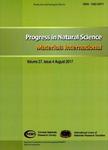Oxygen isotope geochemistry of phosphorite and dolomite and palaeo-ocean temperature estimation:A case study from the Neoproterozoic Doushantuo Formation, Guizhou Province, South China
Oxygen isotope geochemistry of phosphorite and dolomite and palaeo-ocean temperature estimation:A case study from the Neoproterozoic Doushantuo Formation, Guizhou Province, South China作者机构:Nanjing Univ Dept Earth Sci State Key Lab Mineral Deposits Res Nanjing 210093 Peoples R China
出 版 物:《Progress in Natural Science:Materials International》 (自然科学进展·国际材料(英文))
年 卷 期:2004年第14卷第1期
页 面:78-85页
核心收录:
学科分类:070902[理学-地球化学] 0709[理学-地质学] 07[理学]
基 金:SupportedbytheNationalNaturalScienceFoundationofChina (GrantNos.40 172 0 41 40 2 3 2 0 2 0and40221301)andtheTransCenturyTrainingProgrammefortheTalentsbytheMinistryofEducationofChina
主 题:oxygen isotopes phosphate dolomite Doushantuo Formation Neoproterozoic South China
摘 要:The Neoproterozoic Doushantuo Formation at Weng’an in Guizhou Province of South China consists of phosphorites and dolomites. Three types of samples are recongnized for the phosphate bearing rocks. In Type I samples, interstitial phosphates occur within the dolomite rocks, whereas in Type III samples, interstitial dolomites occur within the phosphorites; both of them may have diagenetic origin. The Type II samples are interbedded phosphorites and dolomites. Oxygen isotopic compositions of phosphate and coeval carbonate were analyzed. Phosphates of Type I and II samples show similar low δ 18 O phos (SMOW) values of 10.9‰~12.1‰ and 10.7‰~ 12.8‰ , respectively, whereas Type III phosphates show higher δ 18 O phos (SMOW) values of 13.2‰~15.0‰. Dolomites from Type I and II samples have δ 18 O carb (PDB) and δ 13 C carb (PDB) values of -6.2‰~-3.4‰ and -2.2‰~-0.7‰, respectively, whereas interstitial dolomites from Type III samples show lower δ 18 O carb (PDB) and δ 13 C carb (PDB) values of -12.9‰~-8.6‰ and -4.4‰~-2.6‰. Petrology and oxygen isotope data suggest that diagenetic alteration may have partially affected the studied rocks, but the dolomites from Type I and phosphates from Type III samples represent the most pristine isotopic compositions of primary carbonates and phosphates precipitated from seawater. Calculations of palaeocean temperatures from the most 18 O enriched dolomite and phosphate indicate a temperature range of 32.2 ℃ to 34.0 ℃ for the seawater of the Doushantuo Formation period. Ce anomaly also suggests more oxic conditions and possibly shallower water depth in the upper strata of the Doushantuo Formation at Weng’an, Guizhou Province.



